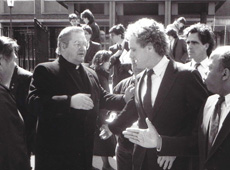Loyalist terror force formed from fear over a ‘1916 in 1966.
Posted By: May 27, 2016
“Historian and Irish News columnist Brian Feeney said it [ the UVF]was responsible for introducing the gun into Irish politics twice during the last century.
“They brought the gun into politics in ‘66 and brought explosives into Northern Ireland,” he said.
“They also brought the gun into politics in 1913 when they formed, and started to import weapons.”
The Ulster Volunteer Force was outlawed after two Catholic men and a Protestant pensioner were killed by the group 50 years ago.
It was one of several militant Protestant groups that emerged in the mid-1960s, with Shankill loyalist Gusty Spence among its leaders.
Claiming the name of the UVF, which had formed in opposition to Home Rule more than half a century earlier, it carried out the first sectarian killing of the modern Troubles, three years before republicans claimed their first victim.
The group emerged at a time of unionist fears of a growing republican threat and coincided with the rise of Ian Paisley’s firebrand style of politics.
The UVF went on to carry out more than 500 sectarian murders during the Troubles before finally calling a ceasefire in 1994.
Historian and Irish News columnist Brian Feeney said it was responsible for introducing the gun into Irish politics twice during the last century.
“They brought the gun into politics in ‘66 and brought explosives into Northern Ireland,” he said.
“They also brought the gun into politics in 1913 when they formed and started to import weapons.”
The organisation was responsible for a series of cross-border bomb attacks in early 1969, which at the time were blamed on the IRA.
It was only when Thomas McDowell from Kilkeel in Co Down died after being injured in an attack at a power station at Ballyshannon in Co Donegal that it emerged the UVF was behind the attacks.
The dead loyalist was also a member of Ian Paisley’s Free Presbyterian Church and the Ulster Protestant Volunteers.
Mr Feeney said the UVF existed to resist “any kind of change” both towards Home Rule and Terence O’Neill’s reforms in the 1960’s.
Commentator Roy Garland, who wrote a book about Gusty Spence, said in the lead-up to the 1966 murders unionists feared that republicans were planning a fresh rising in Belfast.
“There was actually concern that there was going to be an attempt to redo 1916 in 1966, that was a real fear,” he said.
“Rumours were being spread, I think deliberately, that the IRA was going to take city hall and do what they did in 1916.
“I think people were being influenced, including the UVF.”
Mr Garland said global fears about communism also played their part in Loyalist thinking, after the leadership of what was left of the IRA following the border campaign had lurched to the left.
“Anything to do with the Cold War was frightening.”
He said both John Scullion and Peter Ward were branded Communists in some loyalist circles in a bid to justify their murders.
“Gusty Spence said that was a lot on nonsense and they were ordinary Catholics in his view.”
He believes that British intelligence along with some in the Unionist establishment may have had a hand in the creation of the UVF.
“One theory to this day is that someone wanted to stir up tensions between the two communities,” he said.
Gusty Spence would later be the man chosen by loyalists to declare their 1994 ceasefires.
He spoke of “abject and true remorse” for the suffering caused during the Troubles.
Mr Garland said he always denied involvement in the 1966 murders.
“He denied anything to do with those killings but did not deny being involved in the situation at that time,” he said.
The former British soldier is regarded by some as having been a major influence in nudging the paramilitary group towards ending its sectarian campaign.
Mr Garland said he took “big risks” later in life.
“Some Unionists will not recognise that because they say he had blood on his hands,” he said.
“Whether he had or not, you have to give credit where it is due.”










